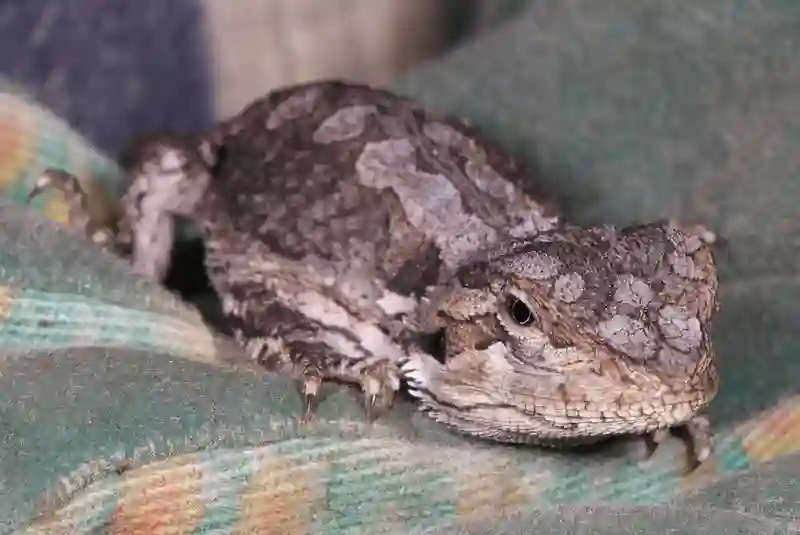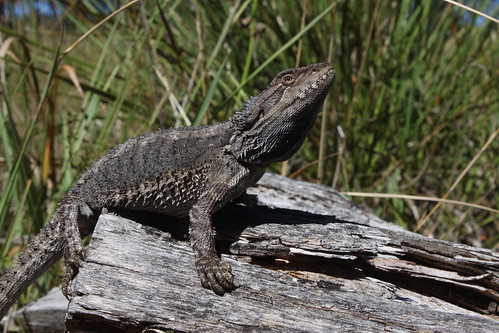Bearded dragons can lose color for various reasons, including shedding, temperature regulation, social signals, stress, breeding, and environmental factors such as lighting, humidity, and diet.
Shedding is a natural process that all healthy bearded dragons go through, and it can cause their scales to look faded in color or milky white. Young dragons shed their entire skin almost every week, whereas adult bearded dragons shed less often in smaller patches.
Do not to pull their skin, as skin that hasn’t finished falling off is just not ready to come off yet. Also, if a bearded dragon is turning white, it could be due to shedding, temperature regulation, stress, breeding, or possible health-related issues.
Common Reasons for Bearded Dragons Losing Color
Shedding: Explanation of the Shedding Process and How it Affects Color
One of the most common reasons why bearded dragons lose their color is due to shedding. Bearded dragons shed their skin regularly, and during this process, they may appear dull or discolored.
This is because the old skin is being replaced by new skin, which can take some time to develop its vibrant coloration. It’s important to note that shedding can be a stressful process for your bearded dragon.
They may experience discomfort or itchiness during this time, which can cause them to become more irritable or agitated. To help your bearded dragon through this process, you should provide them with plenty of water and a warm, damp environment in which to shed.
Stress: How Stress Can Cause a Bearded Dragon to Lose Color and Ways to Reduce Stress
Stress is another common reason why bearded dragons may lose their color. This can be caused by a number of factors such as changes in their environment or diet, handling too frequently, exposure to loud noises or unfamiliar people/pets, and overcrowding among other things.
When stressed out, bearded dragons may become more inactive than usual and change their feeding habits leading up to weight loss if not addressed early enough.
As a result of stress levels building up over time, there will start losing coloration, especially around extremities such as legs or tail darkening from orange/red/brown hues down toward black/gray.
To reduce stress levels in your bearded dragon you should avoid overhandling them and provide them with an appropriate environment. Make sure they have enough space for exercise within the enclosure and hiding spots when feeling uncomfortable.
Illness: Common Illnesses That Can Cause a Loss of Color and How to Identify Them
Bearded dragons can lose their color due to illness. Some common illnesses that can contribute to a loss of color include metabolic bone disease, impaction, and parasites. These conditions can severely affect the health of your bearded dragon if left unaddressed.
If you notice that your bearded dragon has lost its color and is exhibiting other symptoms such as lethargy or lack of appetite take them for an immediate check-up by an exotic animal veterinarian to prevent the situation from escalating into something far worse.
UVB Lighting: The Importance of Proper Lighting for Maintaining Color in Bearded Dragons
Bearded dragons are creatures that require UVB lighting to maintain a healthy lifestyle. Not only does this lighting aid in color development and maintenance, but it also provides essential vitamins that the bearded dragon needs to survive.
Without proper UVB lighting, a bearded dragon may lose its color and become lethargic due to a lack of vitamin D. It’s essential to understand that not all UVB bulbs are created equal.
It’s recommended that you use fluorescent bulbs designed specifically for reptiles with a minimum output of 10% or higher. Additionally, it’s important to replace these bulbs every six months as they begin to lose intensity over time.
Diet: How Diet Can Affect a Bearded Dragon’s Color
A bearded dragon’s diet plays a significant role in its overall health and coloration. A diet high in beta-carotene, such as dark leafy greens and orange vegetables like carrots, can help enhance their natural coloring and maintain their vibrancy. In addition, feeding them live insects like crickets provide essential protein and promote healthy growth.
On the other hand, feeding your bearded dragon an improper diet can lead to health issues such as obesity or malnutrition. This can cause their coloring to fade or change due to the lack of necessary nutrients in their diet.
Genetics: Certain Genetic Traits That May Cause a Loss or Change in Color
Just like humans have certain genetic traits passed down from parents, so do bearded dragons have specific genes that affect their coloring. These traits can cause loss or changes in coloration over time.
One example is the “translucent” gene found in some bearded dragons. This gene causes them to have less pigmentation throughout their bodies, leading them to lighter colors and sometimes transparent skin.
Another example is the “hypo” gene, which causes a bearded dragons to have a lighter color than their counterparts due to reduced melanin production. Understanding these genetic traits and their effects on coloring can help owners make informed decisions when choosing a bearded dragon or when breeding for specific colors.
Some Extra Details on Bearded Dragon Color Loss
Age: How Age Can Affect a Bearded Dragon’s Color
One of the rarely known details about bearded dragon color loss is that age can have an impact on their coloring. As bearded dragons age, they may begin to lose their vibrant colors and become duller in appearance.
This is a natural process that occurs as they mature and is not necessarily a sign of illness or stress. However, it’s important to differentiate between natural aging and other factors that may cause loss of color, such as shedding or illness.
Temperature Changes: Sudden Temperature Changes Can Cause Temporary Loss of Color
Bearded dragons are cold-blooded reptiles that rely on external sources of heat to regulate their body temperature. Sudden changes in temperature can cause stress, which can lead to temporary loss of color.
It’s important to maintain a consistent temperature range in their habitat to minimize any potential stressors. A proper heat gradient within the enclosure will allow your bearded dragon to bask in warmer areas while having cooler areas for when they want some relief.
Hormones: Hormonal Changes During Breeding Season Can Affect a Bearded Dragon’s Coloring
Hormonal changes during the breeding season can also affect a bearded dragon’s coloring. Male bearded dragons will often display brighter colors during the breeding season as a way to attract female mates. These colors are more intense than normal and may last for several weeks before returning back to normal once the mating season has ended.
Conclusion
Recap of Common, Niche, and Rarely Known Reasons for Bearded Dragons Losing Their Colors
Overall, there are many factors that can contribute to a bearded dragon losing its vibrant color. Shedding is a common cause, but it’s important to also consider stress and illness as potential culprits. Additionally, niche factors like UVB lighting and diet can play a role, as well as rarely known details like age and hormonal changes during the breeding season.
The Importance of Monitoring Your Pet’s Health and Environment to Maintain Their Vibrant Coloring
As with any pet, monitoring your bearded dragon’s health is crucial for maintaining its overall well-being. This includes observing their behavior and eating habits, ensuring they have proper lighting and temperature regulation in their enclosure, and scheduling regular check-ups with a reptile veterinarian.
By taking these steps to care for your bearded dragon properly, you’ll not only help maintain their vibrant coloring but also ensure they live happy and healthy lives.



